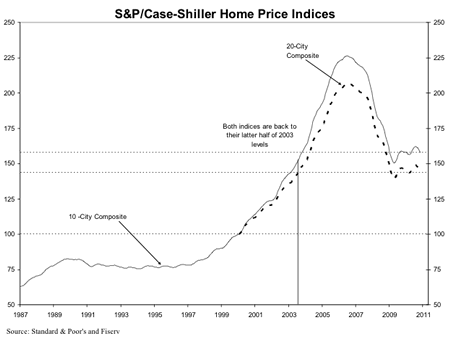The S&P Case Shiller Home Price index was updated yesterday with data through November 2010. Here is the press release [PDF]. Here is the housing price index from 1987 to November 2010. (Click to enlarge.)
I don’t look to closely into these things or like to make crystal ball predictions, but I like to check in occasionally to see what’s happening. It looks like we are still hovering around 2003 price levels.
Selected quotes from the press release:
Data through November 2010, released today by Standard & Poor’s for its S&P/Case-Shiller1 Home Price Indices, the leading measure of U.S. home prices, show a deceleration in the annual growth rates in 17 of the 20 MSAs and the 10- and 20-City Composites compared to what was reported for October 2010. The 10-City Composite was down 0.4% and the 20-City Composite fell 1.6% from their November 2009 levels. Home prices fell in 19 of 20 MSAs and both Composites in November from their October levels.
In November, only four MSAs – Los Angeles, San Diego, San Francisco and Washington DC – showed year-over-year gains. The Composite indices remain above their spring 2009 lows; however, nine markets – Atlanta, Charlotte, Chicago, Detroit, Las Vegas, Miami, Portland (OR), Seattle and Tampa – hit their lowest levels since home prices peaked in 2006 and 2007, meaning that average home prices in those markets have fallen even further than the lows set in the spring of 2009.

 The Best Credit Card Bonus Offers – 2025
The Best Credit Card Bonus Offers – 2025 Big List of Free Stocks from Brokerage Apps
Big List of Free Stocks from Brokerage Apps Best Interest Rates on Cash - 2025
Best Interest Rates on Cash - 2025 Free Credit Scores x 3 + Free Credit Monitoring
Free Credit Scores x 3 + Free Credit Monitoring Best No Fee 0% APR Balance Transfer Offers
Best No Fee 0% APR Balance Transfer Offers Little-Known Cellular Data Plans That Can Save Big Money
Little-Known Cellular Data Plans That Can Save Big Money How To Haggle Your Cable or Direct TV Bill
How To Haggle Your Cable or Direct TV Bill Big List of Free Consumer Data Reports (Credit, Rent, Work)
Big List of Free Consumer Data Reports (Credit, Rent, Work)
Prices will remain weak for some time. Banks still have large inventories of homes that they need to release to the market. Until the economy starts to show real growth, foreclosures will continue
Zillow has been whacking about $1,000 every three days off my Seattle area home since end of November. Local experts forecast that we will be back to 2007 levels (our peak) no sooner than 2017. I could see us dropping further to 2002 level in 2012 (double-dip) before making a move back up. Ugly with a capital Uggggh.
Are the Case-Shiller Home Price Index figures as shown in the chart inflation adjusted?
It looks like Year 2000 is taken as “100” reference point. Today, the index is around “150”. So does the chart say that home prices are still 50% higher now than year 2000 in real (inflation-adjusted) terms?
Yes, according to the S&P website, the Indices have a base value of 100 on January 2000. I don’t see anything about them being adjusted for inflation on this chart. There are inflation-adjusted versions of this chart, but I don’t think this one is.
I wonder if that little 1-2% down turn at the end of the graph is the 2nd half of the double dip people are talking about?
My home is currently at about 2005 level. Thats about 20% higher than 2000 prices.
Since most markets are down 1/3 or more off the peak it would take at least 5 years of 5% growth to return to the 2006-2007 highs. Most markets can’t expect 5% annual growth so it should be mroe like 7-10 years till we hit the peaks again.